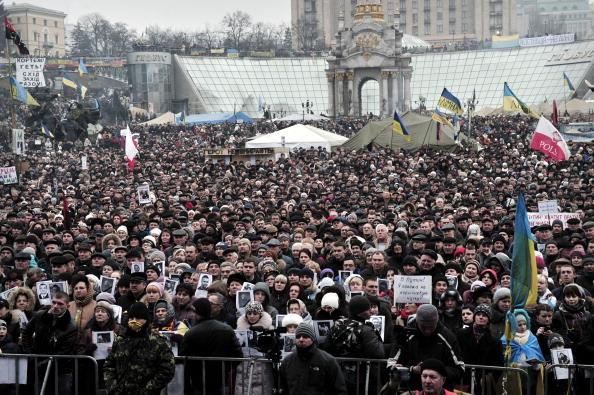Ukraine appears to be heading towards another crisis. Protests in the eastern cities of Kharkiv, Luhansk and Donetsk have turned violent and pro-Russian protesters occupied government buildings, calling for a referendum on independence. In Donetsk, in an eerie echo of events in Crimea, separatists went one step further and have now proclaimed their own independent Donetsk People’s Republic and asked Russia for support.
There is little doubt that these events are being orchestrated by Moscow to increase pressure on the interim government in Kyiv and its Western backers. With presidential elections scheduled for May 25 alongside 27 mayoral contests, the political situation is becoming ever more tense. Anti-Russian sentiment in western and central Ukraine is likely to reach new heights; this will in turn raise the levels of unease among the more pro-Russian minded populations in eastern Ukraine. While anti-Russian protests have continued to demonstrate resistance to the Kremlin’s continued meddling, there is therefore also a genuine base of resentment into which Moscow can easily tap.
But the effort to stoke unrest in Donetsk is not just opportunism; Donetsk and the wider Donetsk region are strategically valuable for both Moscow and Kyiv. Highly industrialized and highly urbanized, the region contains around 10 percent of Ukraine’s population and contributes some 25 percent of Ukraine’s GDP.
After the collapse of the Soviet Union, and the anarchy and criminal turf wars that followed, the eastern region’s local elites supplanted already corrupt formal institutions with informal ones, effectively blocking the nascent Ukrainian state from establishing new regional institutions of its own. This set-up included bribery, shadow negotiation between elite groups, and informal justice mechanisms that replaced corrupt courts. None of this looks positive from the perspective of good democratic governance, but it did at least mean peace could be maintained between the different social groups inside the Donetsk region, as well as between Donetsk and Kyiv.
The perpetual weakness of Ukrainian state institutions got even worse under President Yanukovych, who originates from Yenakievo in the Donetsk region. Yanukovych extended the “Donetsk matrix” to Kyiv and other regions. During his period in office, upwards of 70 percent of ministers, deputy-ministers, judges of the constitutional, supreme and other courts, central and regional prosecutors, heads of regional tax-administrations, etc. were originally from the Donetsk region.
Under Yanukovych, formal institutions (such as the national parliament, local and regional councils and courts) functioned simply as a cover for informal negotiations. As a result of change in the government in Kyiv, the “Donetsk matrix,” however, is again competing with the weakening Ukrainian state—and is therefore potentially undermining the country’s future existence.
Chaos on the March
Against the background of the threat of a Russian military invasion, likely to be justified by the “need” to protect ethnic Russians and Russian-speakers in Ukraine, local clashes between pro-Russian and pro-Ukrainian activists are the symptom, not the cause, of the ongoing instability and insecurity in Ukraine’s eastern regions. Three major factors account for this continuing crisis: fertile ground for instability in the eastern region, the collapse of the Ukrainian economy, and the easy access the protesters have to resources, including finances and weapons.
The number of protesters and the ease with which they have taken and (so far) held on to regional government buildings illustrates both the weakness of the Ukrainian state and the precedent that the “Crimean model” has created. Political instability in Kyiv and conflicting loyalties on the ground are making it ever harder for the state it deal with the crisis in Ukraine’s eastern periphery, while Moscow’s actions in Crimea and its support for the east’s pro-Russian protesters are fuelling further local escalation.
These already difficult dynamics are made worse by the near-bankruptcy of the Ukrainian state, as well as the social and economic pressures that are likely to result from difficult structural reforms and an impending “gas war” with Russia.
One of the greatest dangers is the ready availability of money and small arms supplied by each side’s respective backers. Because of these ample supplies, the situation on the ground can quickly spin out of control, violence begetting more violence and informal institutions failing—just as formal Ukrainian state institutions failed a long time ago.
Any solution to the crisis in eastern Ukraine (as in the country more broadly) will require a long-term strategy to address the weakness of the Ukrainian state. But what the current eastern escalation requires above all is short-term crisis management.
Given recent events, Russia is not a likely partner in any constructive approach to the problem. The government in Kyiv and its Western partners should make every effort to reach out to local residents and political and economic elites in Kharkiv, Luhansk and Donetsk and mount a credible alternative to what might otherwise become all too easily a self-fulfilling prophecy: the further dismemberment of Ukraine.
Local political elites and ordinary residents of the eastern regions of Ukraine (the overwhelming majority of whom are ethnic Russians and Russian-speakers) have by necessity always had to rely on informal institutions in their daily life, and never developed any real trust in the state. They now hedge their bets and remain, so far, neutral in the fight between Kyiv and Moscow. All hope is not lost—but the window of opportunity for local crisis management is rapidly closing.
Stefan Wolff is a professor of international security at the University of Birmingham in the U.K. Tatyana Malyarenko is a professor of public administration at Donetsk State Management University in Ukraine. This article was previously published on TheConversation.com




